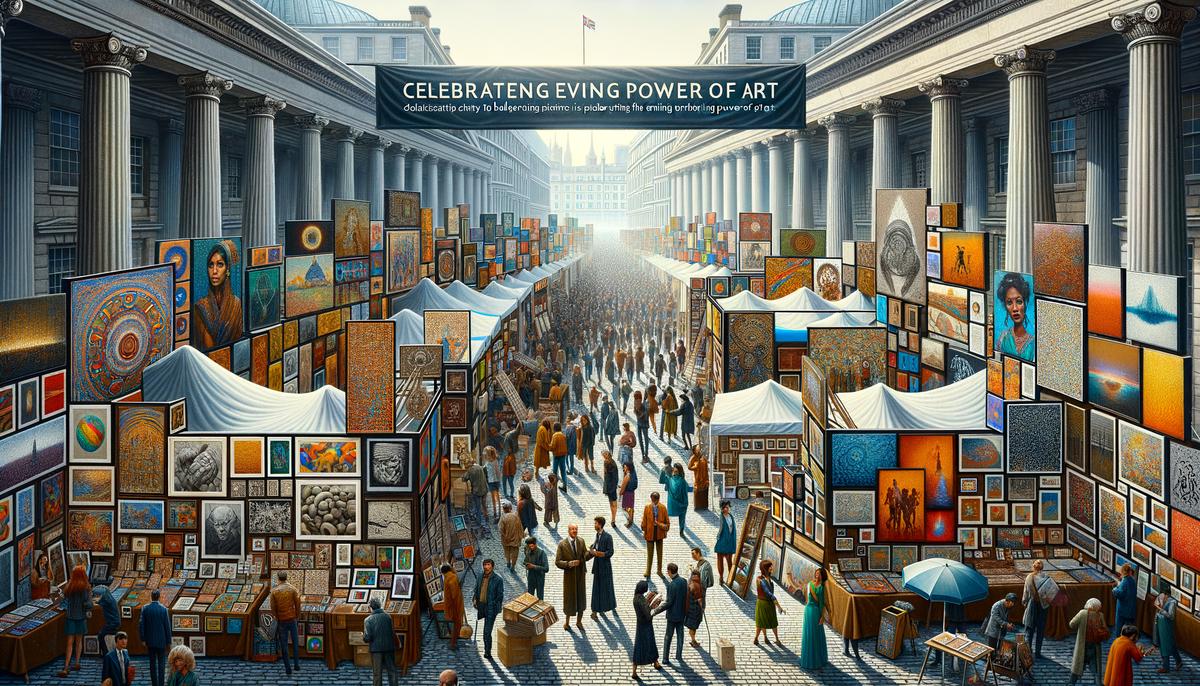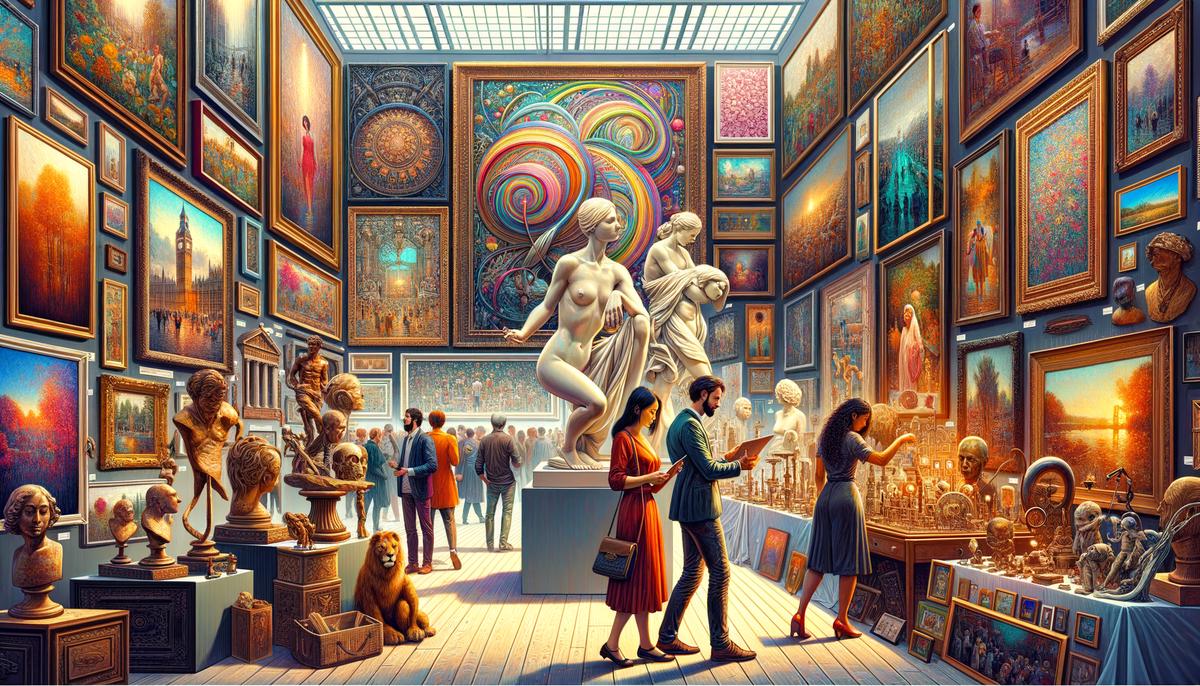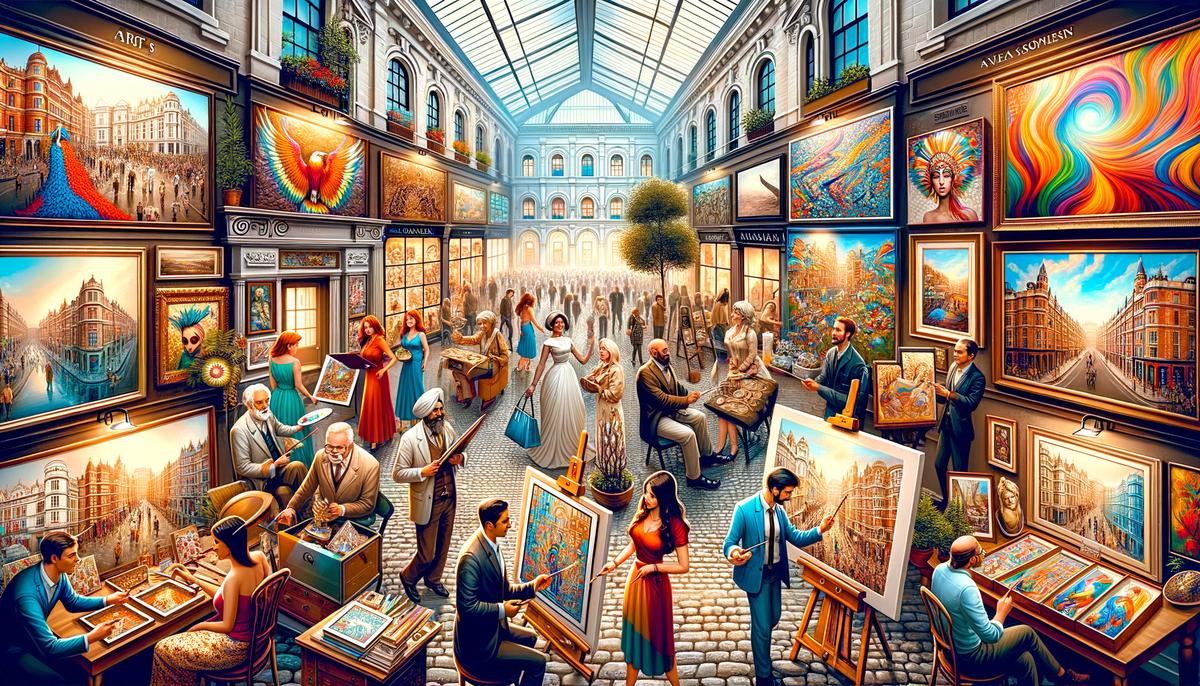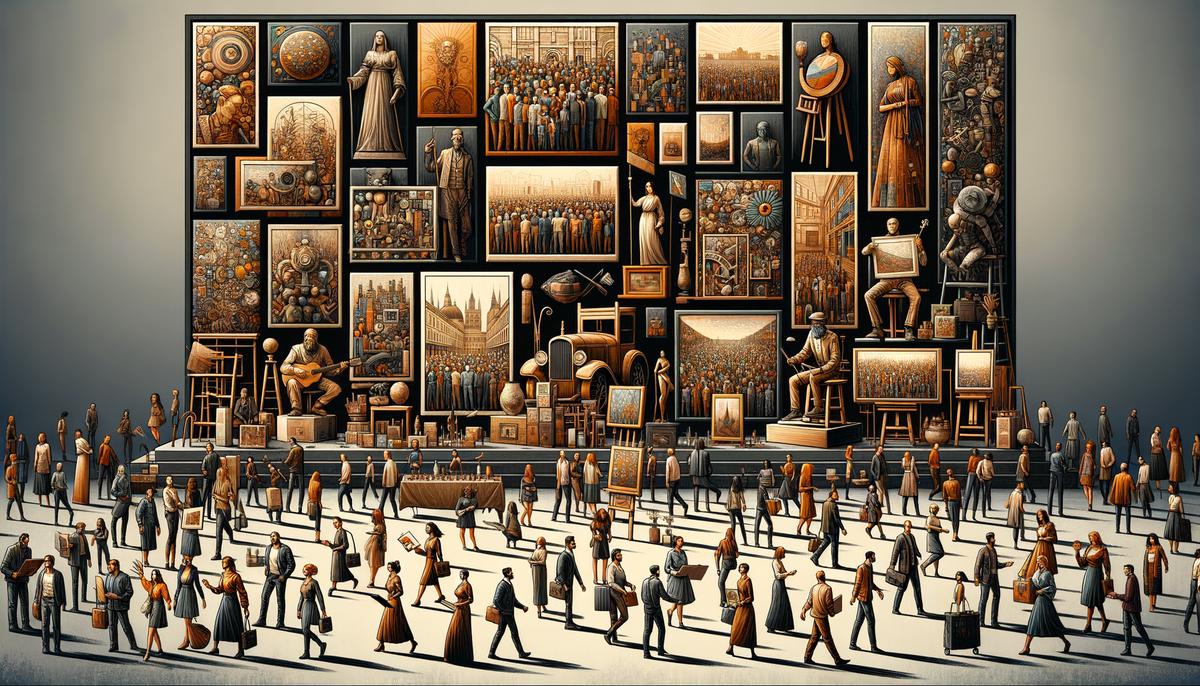London art fairs are exciting events where people from all over the world come to see and buy art. These fairs are important because they show a wide range of art, from very old pieces to the newest creations. The article talks about how these fairs are good for everyone – whether you know a lot about art or just like to see beautiful things. It also mentions how these events help artists and art lovers connect, and make London a special place for art.
Overview of London Art Fairs
London art fairs stand as a magnetic force in the global art scene, drawing enthusiasts, collectors, and artists from every corner of the world. The city, steeped in a rich tapestry of history and culture, sets a magnificent stage for these fairs, offering a unique blend of the traditional and the contemporary. Among the bustling activities, London art fairs shine brightly, showcasing a diversity that is both exciting and educational.
One of the key factors that elevate London’s status on the global art map is its legacy of art appreciation and patronage. Venues like the Frieze Art Fair and the London Art Fair have become hallowed grounds, presenting works that range from the cutting-edge contemporary to historically significant masterpieces.
Frieze London, for example, transforms Regent’s Park into an epicenter of contemporary art, attracting galleries and artists who are the vanguards of creativity. It’s not just about viewing art; it’s an immersive experience where one can participate in talks, discover emerging talents, and witness art-making in real-time. This inclusivity and openness to explore various art forms contribute to its global appeal.
On the other hand, the London Art Fair focuses on modern British art but also opens its doors to international exhibitors, offering a rich panorama of art from the 20th century to today. Its location in the cultural hub of Islington provides an ideal backdrop, placing it within a nexus of galleries and artistic activity in the city.
What makes these fairs truly global attractions, however, is their unparalleled ability to forecast trends, foster connections, and facilitate the exchange of ideas. Collectors from Asia, the Middle East, and the Americas converge in London, seeking not only to acquire new works but also to gauge the pulse of the global art market. The fairs serve as barometers for what is resonant, challenging, and beautiful in the art world.
Moreover, the city itself amplifies this attraction. London, with its museums, galleries, and street art, is a sprawling canvas that reflects the past and the present. Visitors often extend their stay to explore historical sites like the Tate Modern or the National Gallery, further enriching their cultural journey.
The blend of accessibility and exclusivity is another factor. While the art displayed ranges from the affordable to the astronomically priced, the fairs are designed to be inclusive, welcoming seasoned collectors and curious newcomers alike. It’s this democratic approach to art appreciation that demystifies the art world and makes it approachable.
Finally, London art fairs act as cultural bridges, showcasing a plethora of artworks from various countries and cultures. This diversity not only supports a global community of artists but also provides attendees with a microcosm of the world’s artistic output.
In essence, London art fairs are more than just events; they are vibrant cultural phenomena that celebrate creativity, diversity, and the enduring power of art. Through their comprehensive offerings and the city’s dynamic backdrop, these fairs continue to captivate and charm a global audience, making London an indispensable node in the international art circuit.

Key London Art Fairs
Navigating the vibrant landscape of London’s art scene brings us to two more fairs that stand as beacons for those in search of the next masterpiece: The Masterpiece London and 1-54 Contemporary African Art Fair. Both events, each with a distinct character and focus, complement the eclectic thrum of art appreciation in London, further enriching the city’s cultural tapestry.
Masterpiece London, a fair that prides itself on a fusion of art, antiques, and design, has gained recognition for its eclectic mix, presenting works that span millennia. From ancient sculptures to contemporary installations, the fair is a treasure trove of the exquisite and the exceptional. Its setting, typically within the Royal Hospital Chelsea’s historic grounds, introduces a layer of temporal dialogue between the pieces showcased and their environment, offering an unparalleled sensory experience. The fair’s rigorous vetting process ensures authenticity and quality, making each visit a reliable venture into the realms of potentially groundbreaking artistry. Here, the discerning collector or the curious onlooker is just as likely to encounter a future museum centerpiece as they are to engage with the stories behind centuries-old artifacts.
On a different note, the 1-54 Contemporary African Art Fair casts a spotlight on Africa and its diaspora, serving as a vibrant platform for underrepresented voices in the global art market. Since its inception, the fair has continuously expanded its reach, operating annually not just in London but also in New York and Marrakech. 1-54’s emphasis on African art not only invites reconsideration of the continent’s rich artistic heritage but also propels into the limelight contemporary artists whose works poignantly address themes of identity, politics, and history. It’s here, amidst the dynamic display of paintings, sculptures, photographs, and installations, that one might stumble upon a piece or artist poised for international acclaim.
Both Masterpiece London and the 1-54 Contemporary African Art Fair enrich the narrative of London’s art scene, offering vantage points from which to view the past, present, and future of artistic expression. They remind us that the search for a masterpiece is not just about the object itself but about the story it tells and the conversation it sparks. As London continues to embrace and celebrate this diversity of voices and visions, its art fairs stand tall as pivotal platforms where the art of today meets the history of tomorrow.

Experiencing Art Fairs Like a Local
Navigating London’s art fairs like a local connoisseur isn’t just about marking dates on your calendar or memorizing the names of emerging artists. It’s a more nuanced journey, a blend of historical context, modern engagement, and a dash of personal intuition. Here’s how to dive deep into these fairs, not just as an observer but as a vibrant participant in London’s thriving art scene.
Start your venture with a bit of prep work. Before stepping foot into any fair, research the featured galleries and artists. Nowadays, every fair has a website loaded with insights about the exhibitors and their offerings. This knowledge does more than fill your conversation toolkit; it helps you navigate the fair with purpose, heading straight for works that intrigue you while being open to discovering new favorites.
Engaging with the artists and gallerists can transform a simple visit into an immersive experience. Ask questions. Show your curiosity about the stories behind the pieces, the chosen techniques, or even the artists’ sources of inspiration. This dialogue not only enriches your understanding but also bridges connections, making the artwork more memorable and personal.
Timing is crucial. While the VIP previews are buzzing, visiting during quieter times allows for a more relaxed exploration. Early mornings or weekdays can afford you the luxury of space without the crowds, giving you an intimate viewing experience as if the art was displayed just for you.
Don’t forget the fringe events that surround these fairs. Workshops, talks, and art walks complement the main exhibitions, offering deeper dives into specific themes or techniques. These events are golden opportunities to see art through the lens of its creators and curators, providing context that enlivens your fair experience.
Your exploration doesn’t end at the exit. London’s public art installations and street art are extensions of the gallery walls, turning the city itself into an open-air museum. Walking tours can reveal hidden gems and stories behind notable murals and sculptures, enriching your cultural journey beyond the confines of the fairs.
Lastly, documenting your visit can help in reflecting on your experience. Whether it’s jotting down thoughts in a notebook or capturing moments with your camera, these records are personal souvenirs, reminders of the art that moved you, puzzled you, or inspired you.
In essence, soaking in London’s art fairs with the finesse of a local connoisseur means weaving through the tapestry of the city’s art narrative with eagerness, knowledge, and a touch of serendipity. It’s about seeing beyond the canvas, finding connections, and letting the art resonate within you. Remember, each fair is a chapter in the broader story of London’s artistic legacy, and you’re there to write your own annotations in the margins.

Future Trends in London Art Fairs
In the dynamic landscape of London’s art world, emerging trends continue to shape the future of the city’s celebrated art fairs, transforming both the presentation and reception of art in ways that stretch beyond tradition. These evolving trends not only reflect the changing tastes and interests of art enthusiasts but also respond to the broader shifts in global culture, technology, and social engagement.
One notable trend is the increasing use of digital platforms to extend the reach and accessibility of art fairs, a necessity that became glaringly evident during the global pandemic. Virtual reality (VR) tours and online viewing rooms are no longer futuristic concepts but integral components of today’s art fairs. This digital evolution allows London’s art scene to transcend geographical barriers, making it possible for a global audience to explore, experience, and even purchase art in ways that were unimaginable a decade ago. Such advancements hint at a future where physical attendance may not be the only way to engage with art fairs, offering a hybrid model that combines the best of both virtual and physical worlds.
Sustainability is another emerging trend, with art fairs increasingly emphasizing eco-friendly practices. From reducing waste through digital catalogues and signage to promoting artworks that utilize sustainable materials, London’s art fairs are reflecting a growing consciousness about the environmental impact of such large-scale events. This shift is not only about the operational aspects but also about highlighting artists and works that address environmental issues, making art fairs platforms for critical discussions about sustainability and conservation.
Collaboration across industries is shaping the art fair experience as well. Art and technology collaborations, for instance, are offering new ways of creating and enjoying art, from augmented reality (AR) installations that add a digital layer to traditional artworks to collaborations with tech companies that push the boundaries of what art can be and do. Similarly, cross-industry partnerships, such as those between art fairs and fashion brands or lifestyle companies, are creating immersive experiences that blend art with other aspects of culture and lifestyle, appealing to a wider, more diverse audience.
Another significant trend is the focus on social and political themes, reflecting the role of art as a mirror to society. London’s art fairs are increasingly showcasing works that tackle pressing global issues, from racial and gender inequality to political unrest and the migration crisis. This trend toward more socially engaged art is not only attracting a younger, more socially conscious audience but also fostering a space for dialogue and reflection, underlining the power of art to provoke thought and inspire change.
Finally, the personalization of the art fair experience is gaining traction. With the overwhelming amount of art presented, attendees are looking for more curated experiences that cater to their specific interests. This is leading to more niche fairs and themed exhibitions within larger fairs, as well as personalized tours and recommendations powered by AI and data analytics. The goal is to make the art fair experience more accessible and enjoyable, ensuring that every visitor, whether a seasoned collector or a casual enthusiast, finds something that resonates with them.
As London’s art fairs evolve with these emerging trends, they continue to redefine what it means to experience art in the 21st century. These fairs are not just about buying and selling art; they are about fostering a deep, engaging dialogue between artists, collectors, and the public, and about reflecting and responding to the world in which we live. In this dynamic landscape, London’s art fairs remain at the forefront, shaping the future of art and its consumption in exciting and innovative ways.

The article has shown us that London’s art fairs are much more than places to see and buy art. They are events where people from different parts of the world come together to share their love for creativity and innovation. By highlighting how these fairs are adapting to new trends and making art more accessible to everyone, we understand their lasting impact. Ultimately, these fairs don’t just celebrate art; they foster a global community, encourage important conversations, and keep pushing the boundaries of what art can be in our lives.






















